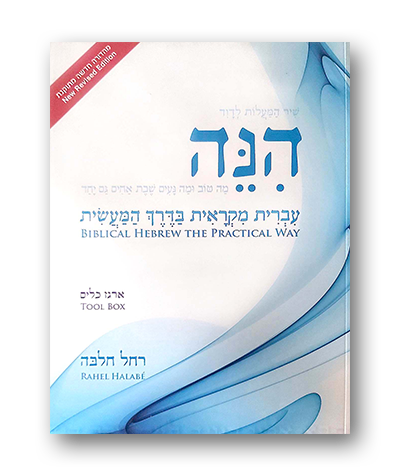
Content Details & Sample Tools
– Your Tool Box includes lists of frequently occurring vocabulary organized in different categories: nouns, verbs, prepositions, etc. It also includes various basic paradigms and different noun, preposition and verb parsing charts.
– Use colored tabs to help you find your way among the different Tools in your Tool Box.
– You may consider taking the Tool Box apart or, better, photocopying the most useful pages as you progress. This will allow you to spread the Tools in front of you while working, and to be able to see a few at a glance, make comparisons (e.g. between different root group paradigms, and verb lists of different stems and forms) and find what best fits the elements in the text you are reading and translating.
– While translating, look up words first in your Tool Box. Refer to your Lexicon only if you do not find them there.
– As you progress through the lessons, familiarize yourself with the relevant common vocabulary. This will help you build up your competence and save you time looking up words in the Lexicon. It will also help you internalize forms and patterns that can be transferred to less common vocabulary.
– Do not learn the vocabulary simply in alphabetical order. Determine your personal priorities, and gradually memorize the vocabulary by relevance, importance, familiarity with cognates, etc.
– A variety of parsing charts are offered. Working through these parsing charts will train you in ‘chopping’ off prefixes and suffixes, identifying forms, recognizing free standing words and looking them up in your Tool Box or your Lexicon. Photocopy and use them as required, and later on for especially difficult cases.
Keep consulting this website, which will be continually updated, for further suggestions and tips.
How to Use your Verb Tools
You are offerred two kinds of verb Tools:
1. Basic Paradigms for:
– seven verb stems of the ‘strong’ verbs: קל, נפעל, פִּעל, פֻּעל, הפעיל, הָפעל, התפעל
(Tools No. 11a & 14-17)
– some of the קל major ‘weak’ root groups (Tools 11b-e)
2. Three Frequent Verbs Lists including conjugations in all verb forms: קל, נפעל, פִּעל, הפעיל, התפעל
– א suffix form
– ב prefix form
– ג infinitives, imperative, participle for each of the five main verb stems:
(Tools No. 11 א-ג 17, א-ג 16, א-ג 15 , א-ג 14 , א-ג )
– Use the Frequent Verb Lists together with the various Verb Parsing Charts and the Basic Paradigms.
– The verb is the main player in Biblical Hebrew. Familiarizing yourself with the frequently occurring verbs, first in the קל , and later in the remaining stems, will ease your way into comprehending the Biblical text and save you unnecessary searches in your Lexicon.
– You are not expected to memorize the detailed conjugations of different verbs in your lists with their exact vowels. Rather, your memorizing of basic paradigms, your reading practice, your ability to identify common verb roots, stems and forms, as well as your continued exposure to verbs through study and translation exercises will gradually help you grow out of using these Tools, towards more independent reading of the Biblical text.
– Translations appearing for verbs in the various Frequent Verbs Lists do not necessarily cover all the possible meanings. If the provided translations do not fit the context with which you are dealing, consult your Lexicon to find a more satisfactory translation.
– On the left hand column of every Frequent Verbs List of the Prefix Form ( ב lists) you will find, if existing, the short (or altered) prefix form for הוא & היא (Volume I, Lessons 41-43; Volume II, Lessons 12-23), which is different from the regular prefix form for these persons. In order to draw your attention, both are printed in bold letters.
– Bold print is also used to draw your attention to cases such as: assimilated ת or ט e.g. שִׁחַתֶּם instead of שִׁחַתְתֶּם. ות or ת – endings for ‘weak’ verbs’ infinitive construct e.g. שֶבֶת, רְאוׂת
– Color coding is an important ‘organizer’ in the Hinneh program, when learning the verb system. Use colored pencils or highlighters as instructed throughout the lessons, to help you distinguish among the different ‘weak’ root groups (see example ). You may also want to follow suggestions for photocopying the various verb paradigms onto paper of differing colors. For more details see Presentation of the Hebrew Verb System in the classroom
– Note: Some roots are not consistent in ‘behaving’ like verbs of a single root group. When they appear in different forms and stems, you may be instructed to color them in different colors to reflect that fact.
